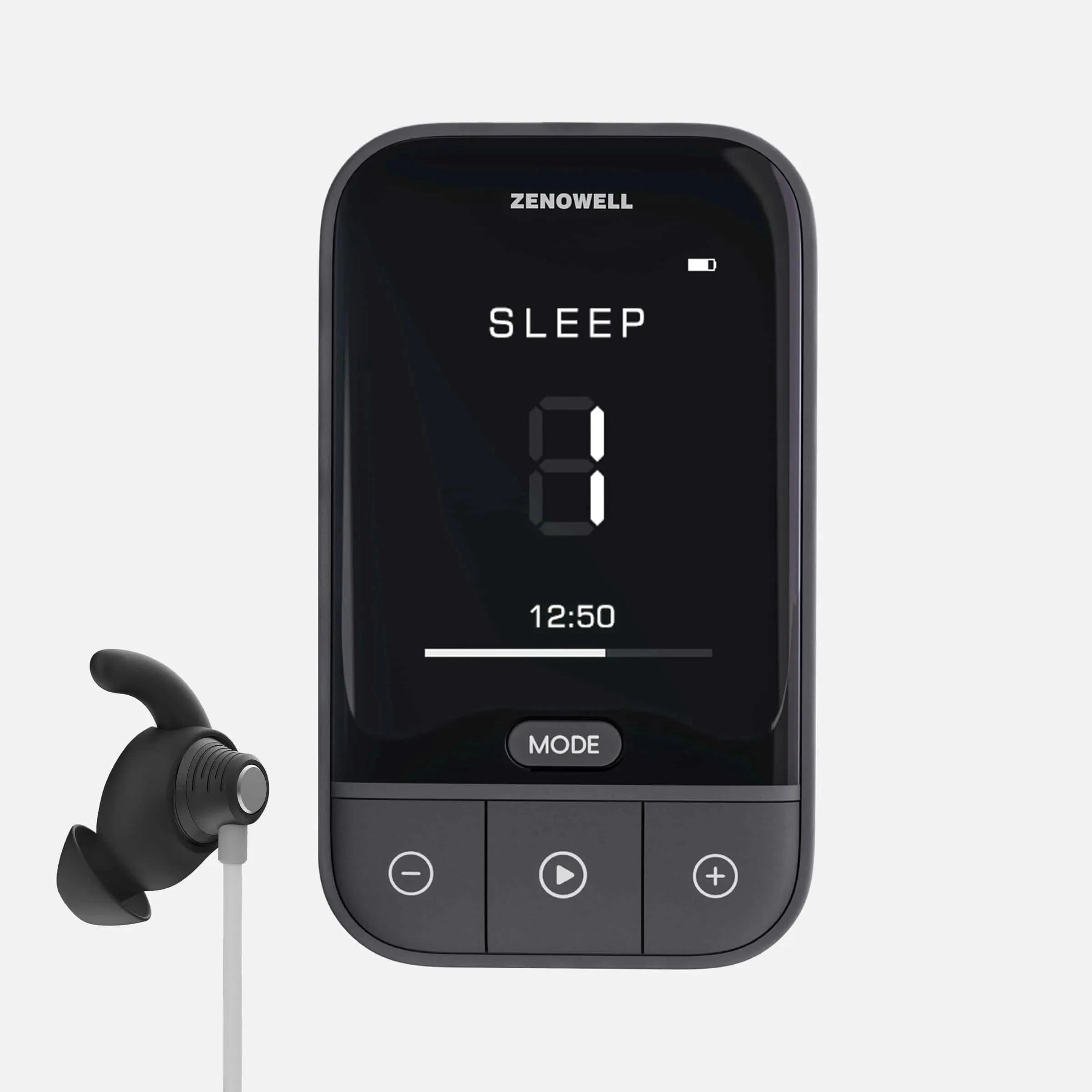Can taVNS Help Improve Type 2 Diabetes or Its Complications?
Type 2 Diabetes (T2D) is more than “high blood sugar”. It is a chronic metabolic, inflammatory, neuro‑immune, and circadian challenge. Beyond glucose targets, autonomic imbalance, low‑grade inflammation, gut–brain signaling disruptions, altered appetite hormones, mood, sleep quality, and microvascular function all shape long‑term risk. That multidimensional complexity is why non‑invasive adjuncts like transcutaneous auricular vagus nerve stimulation (taVNS) are drawing attention. But: Are we there yet? Not quite. Let’s separate plausible mechanisms from proof.
What Is taVNS?
taVNS delivers mild electrical impulses to the auricular branch of the vagus nerve located in your ear. This nerve plays a significant role in regulating stress, mood, and sensory processing. As the stimulation occurs in the ear, it’s natural to wonder if taVNS could alleviate tinnitus, particularly when stress is a major trigger.
Why the Vagus Nerve Matters in Metabolic Health
Potential interface points between vagal signaling and T2D pathophysiology:
- Inflammation & Immune Tone: The cholinergic anti‑inflammatory pathway (acetylcholine acting on α7 nicotinic receptors) may attenuate pro‑inflammatory cytokine release that worsens insulin resistance.
- Gut–Brain Axis & Motility: Vagal afferents convey mechanical and chemical signals impacting satiety, gastric emptying, and incretin interactions.
- Appetite & Energy Intake: Modulation of ghrelin and potentially orexin circuits may influence hunger and weight trajectories.
- Autonomic Balance: Reduced heart rate variability (HRV) is a cardiometabolic risk marker; parasympathetic support may relate to vascular and glycemic outcomes indirectly.
- Sleep & Mood: Sleep fragmentation, anxiety, or depressive symptoms can degrade glucose control; vagal neuromodulation is being explored for mood and sleep quality support.
- Microvascular & Endothelial Function: Autonomic tone affects microcirculatory perfusion, relevant for wound healing and neuropathy risks.
Mechanistic Plausibility vs. Clinical Proof:
- Mechanism-rich rationale does not automatically translate to clinically significant HbA1c reduction. For taVNS, most current diabetes-relevant signals are:
- Indirect (HRV shifts, appetite hormone modulation, inflammatory biomarkers)
- Early-stage animal data
- Small human feasibility or observational insights Large, multi‑month randomized controlled trials (RCTs) focused on metabolic endpoints remain scarce.
Emerging Evidence Snapshot (Early Stage):
Animal and Preclinical Insights:
Orexin / Appetite Pathways: taVNS reduced food intake and attenuated weight gain in high‑fat diet rodent models (e.g., Zhang et al., 2025), suggesting central pathway modulation.
Mood–Metabolism Link: VNS paradigms (implanted and experimental auricular adaptations) have shown effects on depressive‑like behaviors and insulin signaling markers in Zucker fatty rats (Li S. et al., 2014).
Appetite Hormone Modulation: Ghrelin Suppression: Kozorosky et al. (2022) reported that acute taVNS augmented normal postprandial suppression of plasma ghrelin. The theoretical downstream: reduced caloric intake, potential support for weight management. Chronic translation is unproven.
Autonomic / Cardiometabolic Framing: HRV & Vascular Discussion: Thal et al. (2025) review the plausibility of taVNS influencing autonomic balance, microvascular function, and inflammatory status in Type 2 Diabetes–related cardiac vulnerability. This is conceptual—supportive, not definitive.
Neuro-Immune / Long COVID Intersection: Exploratory analyses (Li R. et al., 2024) highlight dysfunctional insulin receptor signaling and pain / inflammation contexts where taVNS is posited as a multimodal regulator. These frameworks may indirectly inform T2D comorbidity management.
Case Observations: Case-level neuromodulation (including auricular magnetic stimulation overlapping vagal zones) has yielded isolated reports of improved peripheral circulation or metabolic markers. Such single cases generate hypotheses; they are not evidence of generalizable efficacy.
Important Clarification: No large-scale, high-certainty human trial has yet demonstrated sustained HbA1c reduction from taVNS alone. Treat current signals as exploratory.
Positioning taVNS as an Adjunct (Not a Replacement)
Potential Indirect Benefits That May Support Better Self-Management:
- Enhanced stress resilience → fewer stress-driven glucose spikes.
- Improved sleep consolidation → insulin sensitivity support.
- Appetite modulation → caloric regulation and weight trajectory.
- Mood stability → adherence to diet, activity, medication schedule.
- GI comfort (in some users) → improved meal pattern consistency.
taVNS is not:
- A substitute for prescribed antidiabetic medications (metformin, GLP‑1 RAs, SGLT2 inhibitors, insulin, etc.).
- A standalone therapy for complications (neuropathy, retinopathy, nephropathy).
- A guaranteed method to lower HbA1c.
ZenoWell’s Commitment:
TaVNS is biologically plausible as an adjunct because it may influence inflammation, autonomic tone, appetite signaling, sleep, mood, and stress—all factors relevant to Type 2 Diabetes management—yet evidence from large human trials showing direct improvements in HbA1c or insulin sensitivity is still insufficient. Early signals (appetite hormone modulation, heart rate variability shifts, animal metabolic models) justify expanded research, not clinical overconfidence. Structured self‑tracking combined with medical collaboration helps minimize placebo misattribution. Devices like ZenoWell offer a practical exploration platform, but they should always remain secondary to prescribed therapies and core lifestyle foundations.
Reference:
1. Li, R., Liu, W., Liu, D., Jin, X., & Wang, S. (2024). The involvement of the dysfunctional insulin receptor signaling system in long COVID patients with diabetes and chronic pain and its implications for the clinical management using taVNS. Frontiers in Pain Research, 5, 1486851.
2. Li, Shaoyuan, et al. "Therapeutic effect of vagus nerve stimulation on depressive-like behavior, hyperglycemia and insulin receptor expression in Zucker fatty rats." PloS one 9.11 (2014): e112066.
3. Kozorosky, Erica M., et al. "Transcutaneous auricular vagus nerve stimulation augments postprandial inhibition of ghrelin." Physiological Reports 10.8 (2022): e15253.
4. Thal, S. C., Shityakov, S., Salvador, E., & Förster, C. Y. (2025). Heart Rate Variability, Microvascular Dysfunction, and Inflammation: Exploring the Potential of taVNS in Managing Heart Failure in Type 2 Diabetes Mellitus. Biomolecules, 15(4), 499.
Zhang, Yingying, et al. "Transcutaneous auricular vagus nerve stimulation inhibits food intake and body weight gain through the orexin dependent pathway in high fat diet mice." Scientific Reports 15.1 (2025): 19286.

















